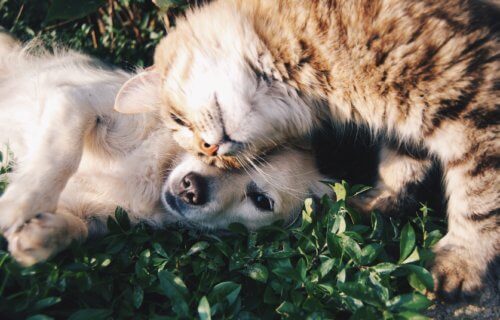“We believe this is the first study of its kind to explore the use of pheromone products to improve the relationship when the two species are living in the same household.”
LINCOLN, England – Cats and dogs are generally thought to be natural enemies. However, a new study by animal behavior scientists at the University of Lincoln suggests that two different types of synthetic pheromones may allow cats and dogs to live in harmony together.
Pheromones are a type of chemical that animals produce and release. They are generally thought to have evolved as a means of communication between members of the same species.
Cats produce and secrete pheromones known as F3 facial pheromones. They deposit these pheromones on surfaces by rubbing their cheeks against them. By doing so, they are essentially marking the area as safe. Synthetic pheromone products, such as Feliway, mimic the F3 pheromone and are available for pet owners to purchase to help calm their cat.
Synthetic pheromone products are also available for dogs. Adaptil, for example, works similarly to Feliway, but mimics dog pheromones and produces calming effects in dogs.
Although the calming effects of Feliway and Adaptil are well known, prior to the University of Lincoln study, it was unclear whether synthetic pheromones could impact the way that cats and dogs interact with each other.
Testing synthetic pheromones in homes with both dogs and cats
To determine whether synthetic pheromones can influence interactions between cats and dogs, the researchers examined the effect of Feliway and Adaptil on cat and dog behavior in homes where the pets were living together. Overall, they found that the products reduce negative interactions. Such behavior includes dogs chasing or barking at cats, cats hiding from dogs, and both pets staring at each other. Further, the products even increase positive interactions, including friendly greetings and relaxing in the same room.
“Although we are all aware of the perceived tensions between cats and dogs, we believe this is the first study of its kind to explore the use of pheromone products to improve the relationship when the two species are living in the same household,” explained researcher Daniel Mills in a statement.
Mills explains that while many homes that have both cats and dogs enjoy harmony, others report stressful experiences. “A poor relationship between a resident cat and dog can have serious consequences for the welfare of individual animals,” he adds. “There may be an unacceptable level of social stress or restricted access to key resources such as food, water or suitable toilet areas. There will also be increased stress for the remainder of the family (both human and animal), and potential risks of injury due to conflict.”
Poor relationships between new pets and existing ones are among the most common reasons for animals to wind up in shelters. Thus, these findings point toward an alternative solution for creating a happy and healthy pet environment without having to re-home one or more pets.
The study is published in Frontiers in Veterinary Science.
Like studies? Follow us on Facebook!
